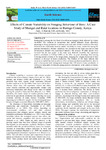Effects of Climate Variability on Foraging Behaviour of Bees: A Case Study of Marigat and Ratat locations in Baringo County, Kenya
| dc.contributor.author | Akala, Haron | |
| dc.contributor.author | Makindi, Stanley Maingi | |
| dc.contributor.author | Esilaba, Moses | |
| dc.date.accessioned | 2019-07-15T17:27:50Z | |
| dc.date.available | 2019-07-15T17:27:50Z | |
| dc.date.issued | 2018 | |
| dc.identifier.uri | http://ir.mksu.ac.ke/handle/123456780/4596 | |
| dc.description.abstract | Beekeeping is among the livelihood diversification strategies likely affected by climate variability. The variation in temperature and rainfall influence forage phenology impacting on honey production in arid and semi-arid lands (ASALs) in Kenya. The study focused on the relationship between rainfall variability on honey production among the pastoral communities. Rainfall variability was exhibited in the study area and in some circumstances drought was experienced annually. On average, 19 plant species were recorded that the bees prefer in the study area. Rainfall variability has significant positive correlation (r=0.423;p=0.001) on the effect on plant phenology thus altering flowering periods of many of the forage plants, changing the foraging behaviour of bees resulting to decrease in honey production. The findings of this study indicate that variation in rainfall has had an adverse effect on honey production and therefore there is need to incorporate land management strategies that will improve honey production in ASALs for sustainable livelihoods among pastoral communities in the context of climate variability. | en_US |
| dc.language.iso | en_US | en_US |
| dc.subject | Climate variability | en_US |
| dc.subject | Foraging Behaviour | en_US |
| dc.subject | Honey production | en_US |
| dc.subject | Phenology. | en_US |
| dc.title | Effects of Climate Variability on Foraging Behaviour of Bees: A Case Study of Marigat and Ratat locations in Baringo County, Kenya | en_US |
| dc.type | Article | en_US |
Files in this item
This item appears in the following Collection(s)
-
School of Environment and Natural Resources [101]
Scholarly Articles by Faculty & Students in School of Environment and Natural Resources

